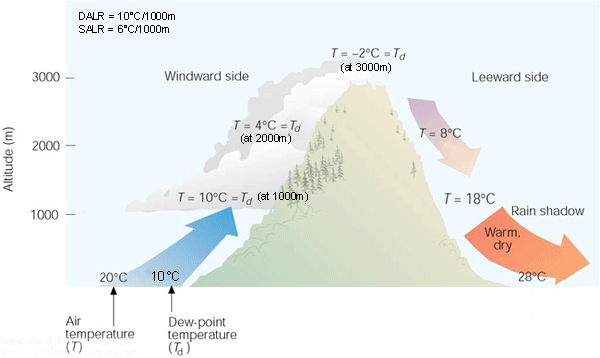|
|
|
|
|
|
|
To do: Print out pdf document for Lab H Exercise - Lapse Rates / Stability and Precipitation Patterns Materials needed: Your atlas, pencil, calculatorPart II. Lapse Rates and Stability To do: Complete all parts. Using the DALR and SALR noted on page H-2, answer the questions in the exercises. Part A. Starting at the bottom and working up, fill in the ovals with the temperature for the parcel at each height. Since the air is unsaturated (as stated in the problem), think about which lapse rate to use. Also, think...what happens to temperature as the parcel rises? Part B. All questions in this section are linked back to Part A. Part D. Be specific in your examples. For each lifting mechanism, pick a city or small region where the lifting process is the MAJOR reason for air being forced to rise. Some locations have more than one process active, but I want the dominant lifting process for the location you select. Since south Florida has already been used in the example of convection, please select another location when answering the question for the U.S. Use the atlas if it helps to pick some cities or regions. Part E. "The Mountain Problem". The air is starting at the surface (sea level here) and will rise up and over the mountain. Question: As the parcel rises, does the air cool or warm? Your answer to this question will determine how the temperature changes. Use the lapse rates provided in the problem and watch your elevations carefully. Example: the DALR is 5.5°F / 1000'. If the air is being lifted over a distance of 3000', the temperature of the air will change by 16.5°F over that height change. Here is an example (using metric units) so you can see how this is done...and read the discussion below the picture.
So we begin the problem at the lowest elevation on the windward side. Note the temperature and dew point at this location. The first question you ask yourself is: "Is the air saturated?" Question: How do we tell if the air is saturated given the information provided in the problem? If the air is not saturated then we use the DALR, if it is saturated (at the ground) then use the SALR. So, is the air saturated at the ground? No. Therefore we will use the DALR and cool the air by 10°C for each 1000 m the parcel goes up. We watch to see when the temperature cools to the dew point and that occurs right away at 1000m. From this point on upwards, the air is saturated and the parcel cools at the SALR of 6°C/1000m (given in the problem). Finally the parcel temperatures ends up at -2°C at the top of the mountain. Part III: Precipitation Patterns
WHEN YOUR LAB IS COMPLETE...Take quiz 8-H_SP.return to top | quit
Date Last Modified: September 12, 2007. |
